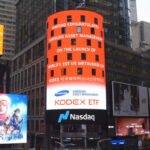SK Hynix mass-produces 36 GB high-bandwidth memory (HBM) chips (Courtesy of SK Hynix)
SK Hynix Inc. said on Thursday it has begun mass-producing the world’s first 12-layer HBM3E with a capacity of 36 gigabytes (GB) for shipment later this year.
It did not identify the customers, but industry observers said they include Nvidia Corp., a graphic processing unit major.
The latest version of high-bandwidth memory (HBM) vertically stacks 12 layers of 3 GB DRAMs. It compares with its predecessor 24 GB HBM3E, the maximum capacity of the fifth-generation HBM to date.
The 24 GB HBM3E interconnects eight 3 GB DRAM chips vertically. HBM chips are best-performing DRAMs essential for AI applications, including large language models.
SK Hynix, the leader in the burgeoning HBM market, said its latest 12-layer HBM3E meets the world’s highest standards in all areas required for AI memory, including speed, capacity and stability. It has raised the speed of memory operations to 9.6 gigabits per second (Gbps), the highest memory speed for an HBM.
“SK Hynix has increased the capacity by 50% by stacking 12 layers of 3 GB DRAM chips at the same thickness as the previous eight-layer product,” it said in a statement. “To achieve this, the company made each DRAM chip 40% thinner than before and stacked vertically using TSV4 technology.”
TSV stands for through silicon via and is an advanced packaging technology.
The company also solved structural issues that arise from stacking thinner chips higher by applying its mass reflow model underfill (MR-MUF) technology.
The MR-MUF refers to the process of stacking semiconductor chips and features 10% higher heat dissipation performance compared with the fifth-generation HBM, or 24 GB HBM3E, according to SK Hynix.
(Courtesy of Samsung Electronics)
SK Hynix is the world’s second-largest memory chipmaker after Samsung Electronics Co. But it stays ahead in the HBM race.
In March, it became the industry’s first to mass-produce eight-layer HBM3E products with 24 GB for supply to Nvidia.
In comparison, Samsung delivered its eight-layer HBM3E samples to key customers in the second quarter of this year for qualification tests, said Kim Jae-june, executive vice president of its memory chip business, during a conference in July.
His remarks came about half a year after Samsung unveiled its 12-layer HBM3E with 36 GB.
By Eui-Myung Park
uimyung@hankyung.com
Yeonhee Kim edited this article













